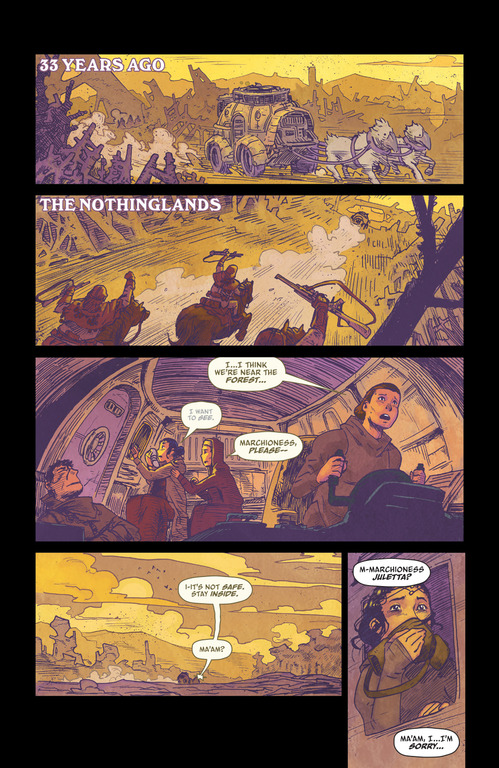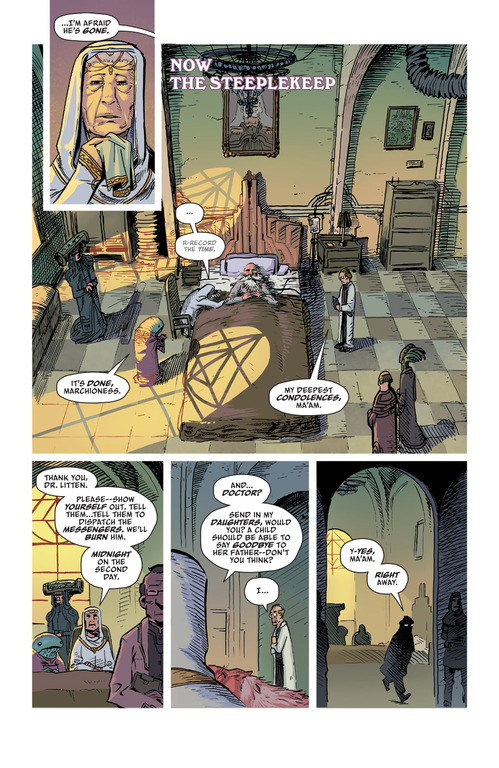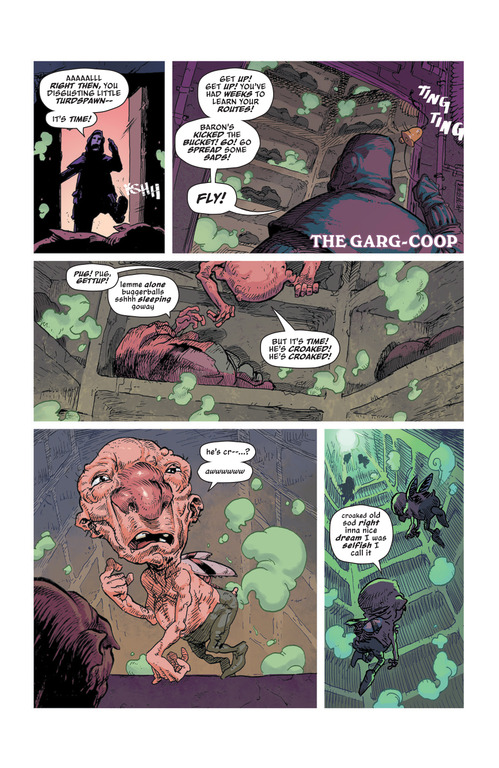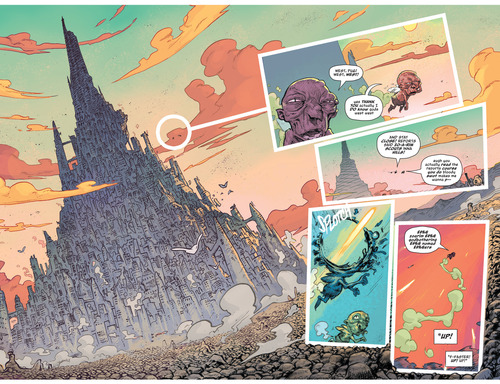Strange Cities, Stranger Crimes and “Glorious Weirdness”: An Interview With Simon Spurrier on The Spire
Setting counts for a lot, and the massive city that gives Simon Spurrier and Jeff Stokely’s recent BOOM! comic The Spire its title is a lesson in how to create something particularly beguiling. Think of China Miéville’s Bas-Lag, or Jeff VanderMeer’s Ambergris-phantasmagorical cities. Strange things abound in these worlds, and yet the fantastical aspects don’t mitigate the worst aspects of human nature. At the center of Stokely and Spurrier’s narrative is Shå, who sports an eyepatch, possesses odd power, and is tasked with investigating a bizarre murder. And while Shå is a compelling enough protagonist on her own, the supporting cast, including an embittered gargoyle named Pug, a petty criminal who speaks in verse and a host of aristocrats enmeshed in intrigue, provides a wider view of the world on display.
As evocative as the setting and characters are, though, The Spire’s small details make it even more compelling. There’s a creative use of lettering, for instance, which accentuates the already-memorable dialogue even more. And there’s a genuinely lived-in aspect to this world, as characters’ histories collide with one another, while the answers to other mysteries lay waiting to be revealed. Paste spoke with Spurrier to learn more about the process of creating The Spire.![]()
Paste: There’s a lot happening in the first issue of The Spire, from horrific murders to palace intrigue to references to events that happened in years past. What was the first part of this world that came to you—the city? Shå?
Simon Spurrier: A good old coalescence of elements, I think. I started with some fairly nuts-and-boltsy type goals, then allowed things to evolve from there. For instance, I desperately wanted to work with Jeff, so it made sense to direct myself towards the areas where our inner fanboys overlap. I wanted to present an idea he literally couldn’t resist, so being able to say “it’s like Bladerunner meets Mad Max by way of The Dark Crystal” was entirely calculated.
Then there were more abstract ambitions. I’ve always wanted to create a fantastical world which feels functional, because I’m weary of genre stories that are contrived purely to enable the story taking place inside them. There’s this really tiresome conventional wisdom that “if you’re creating a new world, the stakes of the story should be world-shaking.” Tell that to Rick Deckard, Roy Batty and co, y’know? I wanted the world we built to feel like it continues to exist when you look away from it, even though the readers—much like its inhabitants—can’t possibly understand everything about it. Hence the world of The Spire is rich with history and strangeness, but rather than slavishly presenting maps and chronologies readers are left to speculate and surmise about a lot of it.
(After all, nobody ever gives those of us living in the real world explanatory notes on the mysteries we encounter every day. How can it possibly enhance the wonder of fiction, let alone the relatability of its characters, to constantly explain everything?)
Lastly, in a slightly perverse sort of way, I wanted us to create a world totally unlike anything our readers have ever seen before…but then to make it one of the least important parts of the story. I wanted our plot to feel intimate, affecting, moving, rather than the usual “THE WORLD IS IMPERILLED!!!” nonsense, which does nothing but widen the scope beyond the point that human concerns resonate. As a direct result of that decision, it made perfect sense to use a murder mystery as the mechanism to drive the story. It’s such an efficient narrative shape for establishing internal logic, getting to know a POV character and exploring the world.
We deviate pretty quickly from a standard Detective Mystery—there’s all sorts of glorious weirdness coming down the pipe—but it’s the familiar-feeling slot we’re asking readers to drop their first few coins into.
At a certain point all these rather prosaic desires and ambitions had spewed-out enough of a foundation that the real fun could begin: devising characters (Shå first of all), and letting the plot evolve alongside them.
In Shå’s case, I wanted a strong, smart, frequently grumpy, often funny, strangely tragic-seeming protagonist whose muddled life would give us access to all sorts of rich thematic marrow, and whose aesthetic look (and skills!) would have people itching to cos-play. Again, upon these unromantic ambitions layers of sedimentary invention settle. There are elements of Shå’s story which can only take place because of the world where she lives—and we’re a long way from seeing the full breadth of what she can do—but if we’ve done our job right she’s also a very sympathetic and human-seeming character, despite being a member of a different species.
-

-

-

-

-

-

-

-

-

-

-

-

-

-

-

-

-

-

-

-

-

-

-

-

-

-

-

-

-

-

-

-

-

-

-

-

-

-

-

-













































